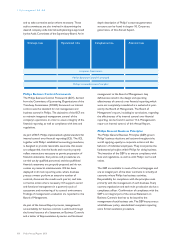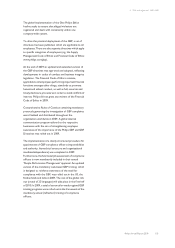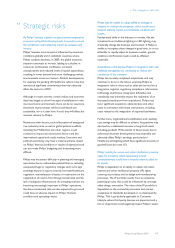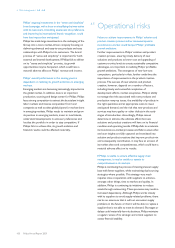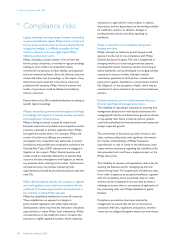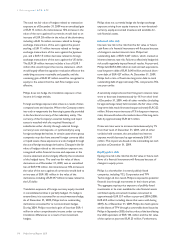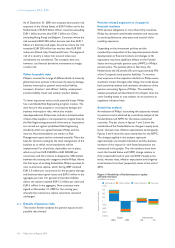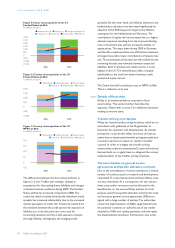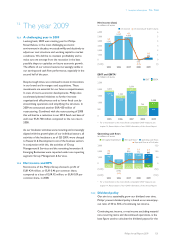Philips 2009 Annual Report Download - page 114
Download and view the complete annual report
Please find page 114 of the 2009 Philips annual report below. You can navigate through the pages in the report by either clicking on the pages listed below, or by using the keyword search tool below to find specific information within the annual report.The total net fair value of hedges related to transaction
exposure as of December 31, 2009 was an unrealized gain
of EUR 15 million. An instantaneous 10% increase in the
value of the euro against all currencies would lead to an
increase of EUR 28 million in the value of the derivatives;
including a EUR 16 million increase related to foreign
exchange transactions of the euro against the pound
sterling, a EUR 11 million increase related to foreign
exchange transactions of the euro against the Japanese
yen, and a EUR 15 million decrease related to foreign
exchange transactions of the euro against the US dollar.
The EUR 28 million increase includes a loss of EUR 1
million that would impact the income statement, which
would largely offset the opposite revaluation effect on the
underlying accounts receivable and payable, and the
remaining gain of EUR 29 million would be recognized in
equity to the extent that the cash flow hedges were
effective.
Philips does not hedge the translation exposure of net
income in foreign entities.
Foreign exchange exposure also arises as a result of inter-
company loans and deposits. Where the Company enters
into such arrangements the financing is generally provided
in the functional currency of the subsidiary entity. The
currency of the Company’s external funding and liquid
assets is matched with the required financing of
subsidiaries either directly through external foreign
currency loans and deposits, or synthetically by using
foreign exchange derivatives. In certain cases where group
companies may also have external foreign currency debt
or liquid assets, these exposures are also hedged through
the use of foreign exchange derivatives. Changes in the fair
value of hedges related to this translation exposure are
recognized within financial income and expenses in the
income statement and are largely offset by the revaluation
of the hedged items. The total net fair value of these
derivatives as of December 31, 2009, was an unrealized
loss of EUR 190 million. An instantaneous 10% increase in
the value of the euro against all currencies would lead to
an increase of EUR 303 million in the value of the
derivatives, including a EUR 297 million increase related to
the US dollar.
Translation exposure of foreign-currency equity invested
in consolidated entities is partially hedged. If a hedge is
entered into, it is accounted for as a net investment hedge.
As of December 31, 2009, Philips had no outstanding
derivatives accounted for as net investment hedges.
During 2009, Philips recorded a gain of less than EUR 1
million in other comprehensive income under currency
translation differences as a result of net investment
hedges.
Philips does not currently hedge the foreign exchange
exposure arising from equity interests in non-functional-
currency equity-accounted investees and available-for-
sale financial assets.
Interest rate risk
Interest rate risk is the risk that the fair value or future
cash flows of a financial instrument will fluctuate because
of changes in market interest rates. Philips had
outstanding debt of EUR 4,267 million, which created an
inherent interest rate risk. Failure to effectively hedge this
risk could negatively impact financial results. At year-end,
Philips held EUR 4,386 million in cash and cash equivalents,
total long-term debt of EUR 3,640 million and total short-
term debt of EUR 627 million. At December 31, 2009,
Philips had a ratio of fixed-rate long-term debt to total
outstanding debt of approximately 73%, compared to 76%
one year earlier.
A sensitivity analysis shows that if long-term interest rates
were to decrease instantaneously by 1% from their level
of December 31, 2009, with all other variables (including
foreign exchange rates) held constant, the fair value of the
long-term debt would increase by approximately EUR 222
million. If there was an increase of 1% in long-term interest
rates, this would reduce the market value of the long-term
debt by approximately EUR 221 million.
If interest rates were to increase instantaneously by 1%
from their level of December 31, 2009, with all other
variables held constant, the annualized net interest
expense would decrease by approximately EUR 31
million. This impact was based on the outstanding net cash
position at December 31, 2009.
Equity price risk
Equity price risk is the risk that the fair value or future cash
flows of a financial instrument will fluctuate because of
changes in equity prices.
Philips is a shareholder in several publicly listed
companies, including TCL Corporation and TPV
Technology Ltd. As a result, Philips is exposed to potential
financial loss through movements in their share prices.
The aggregate equity price exposure of publicly listed
investments in its main available-for-sale financial assets
and listed equity-accounted investees amounted to
approximately EUR 357 million at year-end 2009 (2008:
EUR 659 million including shares that were sold during
2009). As of December 31, 2009, Philips also held options
on the shares of TPV through a convertible bond issued to
Philips in September 2005, the face value of the bond being
the USD equivalent of EUR 146 million and the fair value
of the option at year-end EUR 25 million. Furthermore,
6 Risk management 6.7.2 - 6.7.2
114 Philips Annual Report 2009


